

 The South African
The South African
The local contribution of the village of Cullinan and Premier Mine (new known as Cullinan Mine) in the Second World War (1939-45) is fairly well known. What is less well known is that the area also played a part in the Great War of 1914 to 1918. Consequently, on 4 December 1921, a 'War Memorial Tablet' was unveiled there by Lt-Col D M McLeod, DSO, MC, DCM. It commemorates the 41 men from the district who lost their lives during the Great War.
The brass plaque can still be seen in the main hall of what is now known as the Recreation Centre, originally built as Premier Mine's Recreation Club in 1912. Sadly, research into the names of those who paid the ultimate sacrifice has revealed that at least ten of the men listed had been retrenched when Premier Mine closed in 1916 and may have joined the armed forces as no other Work was available in the area.
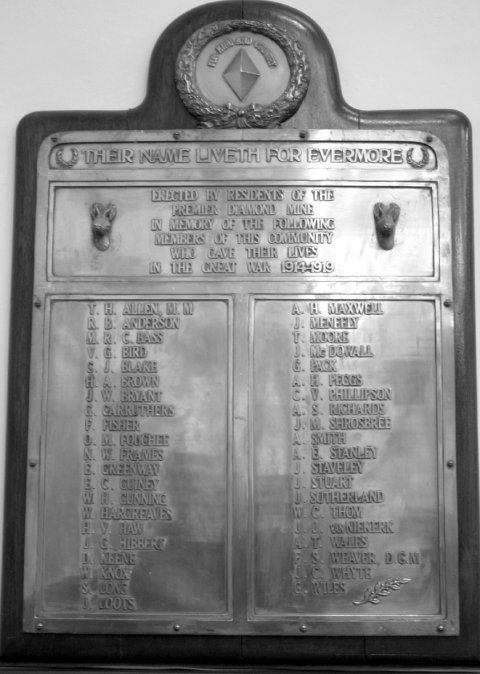
War Memorial Tablet in memory of the men from the community who
lost their lives in the First World War, 1914-1919. The Memorial was unveiled
by Lt-Col D M McLeod, DSO, MC, DCM, on Sunday, 4 December 1921.
The Memorial is located in the Recreation Centre, Cullinan.
A copy of the order of service of the unveiling ceremony of the memorial was also discovered. One of the names on the tablet is F S Weaver, DCM. 80rn in Middlesborough in England, Weaver served in an Australian regiment during the War. His father was an employee of Premier Mine.
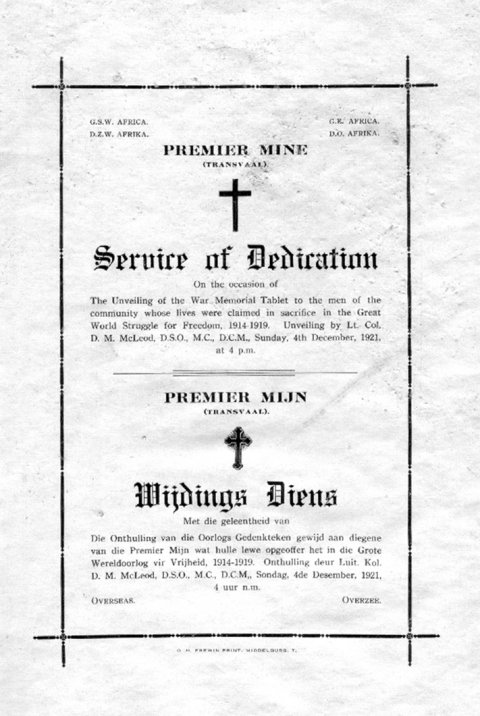
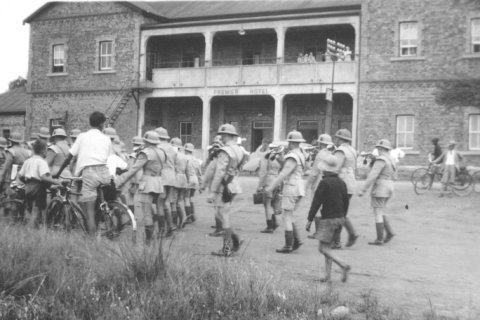
Villagers look on with interest as military servicemen march past the Premier Hotel,
Cullinan, after the establishment of the military camp nearby (CMA).
In 1932, the mine closed for a second time and the village became a virtual ghost town until 1939, when the Union Defence Forces (UDF) arrived. It was probably due to the vacant houses and the abundance of open veld - suitable for practising military manoeuvres - that the military authorities selected the village of Cullinan and the surrounding area as the site for the construction of a massive camp. An added advantage was that the village was connected by the railway network. The decision to construct an Italian prisoner of war camp at Sonderwater (now Zonderwater) was probably influenced by its location well inland and by its close proximity to the large new military camp at Cullinan and Premier Mine.
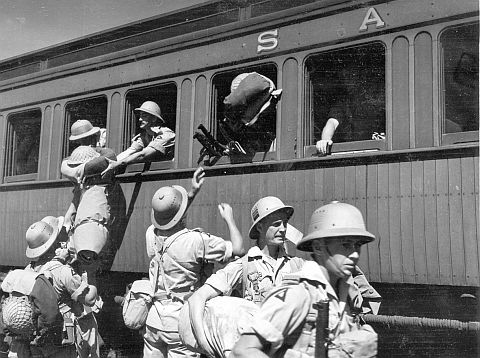
Men of the South African Arnoured Division arrive at
Cullinan Train Station for training at the new military base.
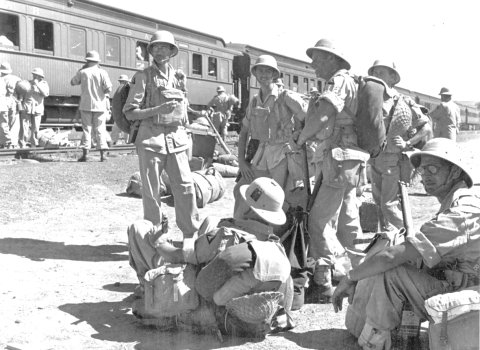
Besides occupying all the empty houses in the area, the Union Defence Forces built massive army camps close to the village, even on the local golf course. The military authorities took over the local hospital as well as the hotel. The hotel bar was for officers' use only. At the hospital, which is still in operation today, a memorial plaque was dedicated to the South African Medical Corps in 1940. Many additional buildings were built around the hospital to enlarge its facilities. The old hospital building itself was constructed in 1908, the cornerstone having been laid by Lady Cullinan. The instruments and operating theatre used by the South African Army doctors are believed to be those now on display in the history room in Oak Avenue.
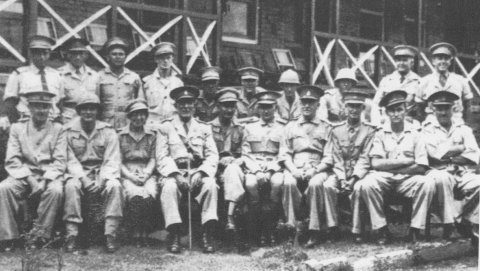
South African Medical Corps staff outside the Premier Mine Hospital during the war (Photo: Cullinan Mine Archives).

This photo and below: Memorial to the South African Medical Corps, at the hospital
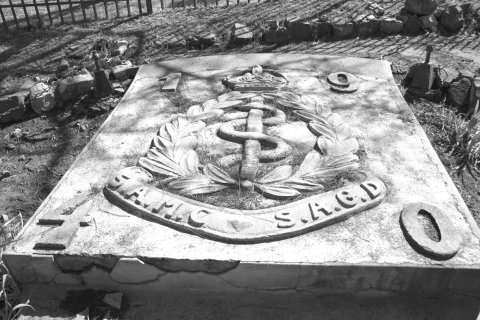
At nearby Zonderwater, there is another memorial plaque to the South African Medical Corps from this period; this one commemorates the services of the Dental Corps.
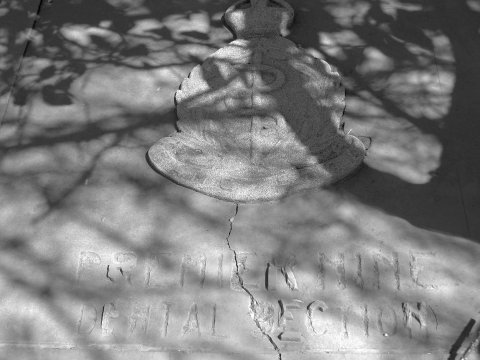
Memorial to the Dental Section of the South African Medical Corps, Zonderwater .
A section of Oak Avenue, the main street leading to the mine, was cordoned off with fencing and guard huts and housed the UDF servicewomen. Off-duty women would meet in the McHardy household, home of the original mine manager, William McCardy, who had arrived there in 1903. Two of his daughters were still living in the house and off-duty servicewomen would meet here to play billiards and cards. Today, the house is a museum.
The local Recreation Club was handed over to the YMCA for the entertainment of troops for the duration of the war. A letter by Lucy Nichol to the Premier Mine's in-house magazine in 1975 recalls the connection between the military authorities and the village of Cullinan.
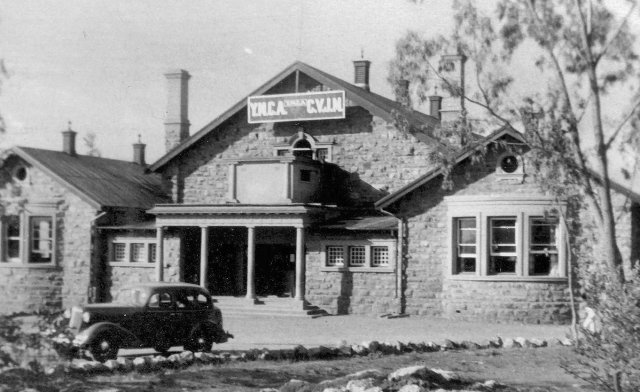
During the Second World War, Premier Mine's Recreation Club was used
by the YMCA (Young Men's Christian Association) as a canteen
and for recreational activities and entertainment for the troops.
(Photo: Cullinan Mine Archives)
Through a chance meeting on a mini-bus in Wankie (now Hwange) Game Reserve in the then Rhodesia (now Zimbabwe), Ms Nichol and a man who had experienced Cullinan during the war years were reminded of the past.
Spoons on string?
On hearing that Ms Nichols came from Cullinan, 'where Premier Mine is', the gentleman asked if she was 'one of the ladies who fastened the teaspoons to the ceiling with string?' Yes, she had been one of the local women who had worked at the Recreation Club during the war, serving in the canteen which had been organised by Mr van Buuren from Johannesburg and had been managed locally by 'cheeky "Mickey" Rooney' with plenty of help from ' ... Messrs H Bennet and O G Philip who handled the projector where needed ... Miss Elie Robson and Mrs Jean Lynott donned khaki and ran the canteen during the day and Mrs Lynott continued alone after Miss Robson left. Miss E McHardy was appointed Commandant and Miss E Cheffins, Adjutant. Mrs D Philip organised the local ladies into shifts to run the canteen in the evenings, beginning at [17.00] and continuing to the end of the entertainment or [until] the last soldier had reluctantly departed.' Ms Nichols recalled that the women 'generally worked two shifts each weekly, but often the cry for help was sent out, "a new draft is in, we are crowded out, collect as many as you can and come at once or sooner. '" As a temperance association, the YMCA sold tea and coffee (at one penny per cup) and a variety of cold drinks, but no alcohol or soda water, which might encourage mixing with strong liquor. 'We all took a turn in the kitchen at the bread-cutting machine, slicing through crates of tomatoes, mash[ing] dozens of eggs, grating pounds of cheese and passed a continuous relay of dishes of sandwiches through the large hatch. At times our customers stood 5 and 6 deep, but when a show started, half would stampede away for a while to surge back at the
interval.' Between the two entrances to the Recreation Hall, there was a long counter with a till, 'stacked with an extensive variety of cigarettes and confectionery, and all those items a man away from home needs, such as writing and mending materials, hankies, penknives and toiletries. '
Referring again to the enigmatic comment about the spoons, Ms Nichols writes that the canteen 'opened with 300 new thick white teacups and saucers, spoons and plates'. These gradually disappeared and were replaced by an additional 200, which seemed to disappear at an even greater rate, partly due to troops carrying them off, and partly due to breakage. As civiliar supplies grew increasingly scarce in the war, expensive glass cups and saucers were acquired and the YMCA workers were instructed to take special care of them. These, too, dwindled over time, to be replaced, eventually, by 'shining silver mugs, no, condensed milk tins, carefully finished off, with inch wide handles soldered on. The point of no return seemed to have been reached when a would-be customer had to first hand in a used mug which we plunged into buckets of hot water under the counter. The evening came when I entered to see three spoons hanging on strings from the ceiling at intervals, each lying neatly on a plate next to a huge bowl of sugar, and even then a customer was seen trying to use a surreptitious pen knife. So that is how Cullinan became famous for "spoons on strings".'
Troop entertainment...
In her letter, Ms Nichols described how bioscope shows were generally held twice a week. 'Concerts of varying talent [and] every play produced in Johannesburg came over for at least one night's free performance. An outstanding occasion was when Noel Coward, who was touring all the camps, came out and provided a full evening's entertainment "for those in uniform only". We were warned beforehand and stories were whispered [a]round of a certain place where he had refused to begin until every civilian had withdrawn. We were very thrilled when extra chairs were erected in the aisles, defying fire regulations and all canteen workers, resplendent in white starched overalls and YMCA badges, together with members of the nursing staff were gathered in. Noel Coward really gave one of his best and held the audience from start to finish. "Don't put your daughter on the stage Mrs Worthington" and the nostalgic "I could have danced all night", excerpts of dialogue from his plays, ... little jokes and big laughs, and song after song.
Never before, or since, can the hall have echoed to such tumultuous cheering and applause.'
'An endearing memory has recently returned to me while thinking of those times' writes Ms Nichols. 'For some reason, possibly bad acoustics, the film shows were given one summer on the natural terrace on the side between the Hall and the main road, and it was most relaxing to sit on a mild evening under a starlit sky with the dark shadowed trees around. Gradually the little golf caddies and their pals would creep up, and sit in rows on the ground at the very front, their reactions very often more fascinating to watch than the film. Local families gathered around complete with prams, the natives shyly stood near, and cars passing along the main road stopped. There was such a feeling of "togetherness".'
One of Ms Nichol's greatest memories of the time was the visit to Cullinan by Mrs Isie 'Ouma' Smuts to 'thank all who were working for "my boys". She was accompanied by her daughter, Mrs Weyers and a senior YWCA lady official, I think ... '
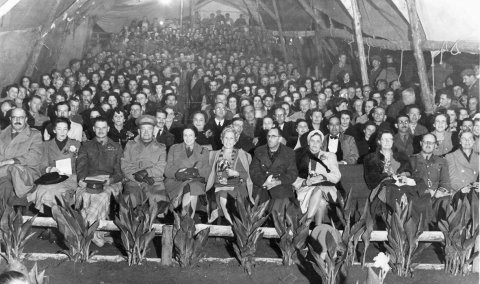
A concert audience, possibly at Zonderwater
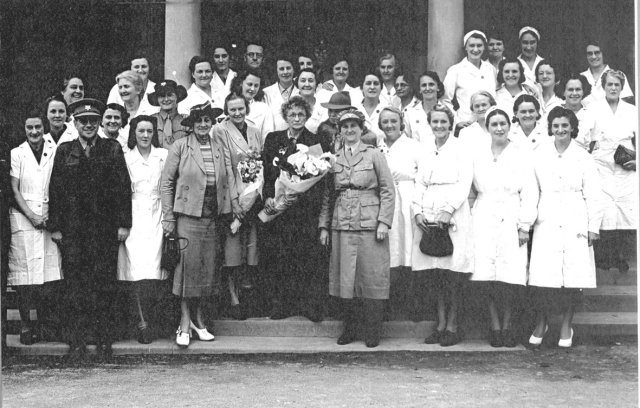
Mrs Isie 'Ouma' Smuts visits Cullinan in appreciation of the local women's war effort.
Mickey Rooney is the soldier in front, left. (Photos: Cullinan Mine Archives)
'Perhaps our war years in Cullinan sound too light-hearted and carefree,' writes Ms Nichols in conclusion, 'but I know there was not one worker in white without some of her family involved in the fighting and there were many anxious times and shared sorrows and personal tragedies before it was over.'
On a koppie to the east of the Village, the men constructed huge stone badges of their regiments. The badges are still in existence, and were painted in 2006. When funds become available again, the weeds around the badges will be removed and weed killer applied to stop the weeds from growing again.
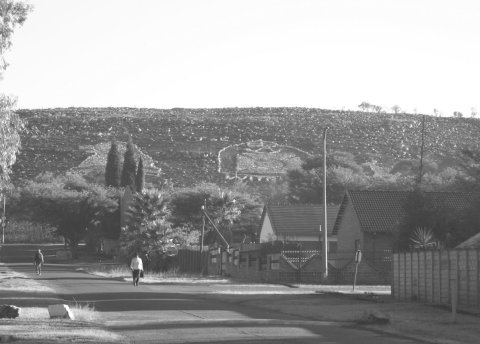
Memories of wartime - A regimental badge of stones
watches over the village of Cullinan from a nearby koppie.
Amongst the military units represented are:
Rand Light Infantry
Central Army Training Depot Imperial Light Horse Kaffrarian Rifles
2nd Royal Durban Light Infantry
Italian Prisoners of War
In the vicinity of nearby Zonderwater there are many other buildings that also have a military connection to the Second World War. Some of these are in the prison block; others are cared for by residents of a house in Zonderwater Road.
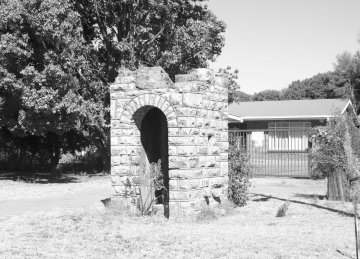
Reminders of wartime. This and the two following photographs
show remnants of military guard posts along the Zonderwater Road.
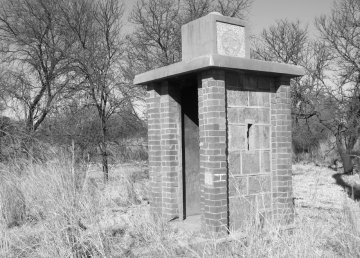
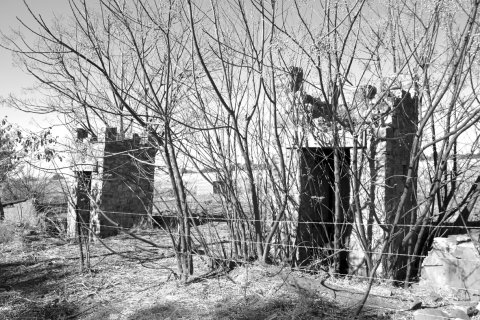
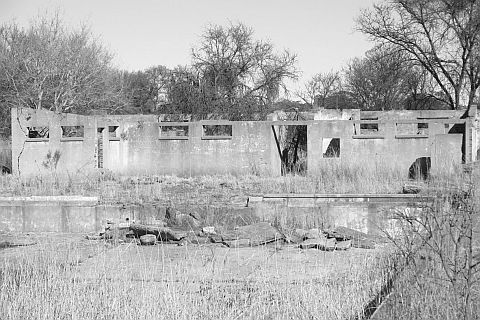
Remnants of the officers' swimming pool and guard hut inside the grounds of Zonderwater.
However, the Italian POWs also left their mark on the Village of Cullinan and in the region. In the main hall of the Recreation Centre, they painted huge murals, probably in about 1942. These were boarded up in 1947 to improve the acoustics of the newly-installed cinema projectors and re-discovered in the late 1990s. Eight murals in all, three are copies of Africana paintings, one is of the Union Buildings in Pretoria, two are London scenes featuring Westminster and Tower Bridge, one is a water scene and one features a sailing ship. It is believed that they were copied from postcards and that more than one artist was involved in this work. The murals have been restored to their former glory.
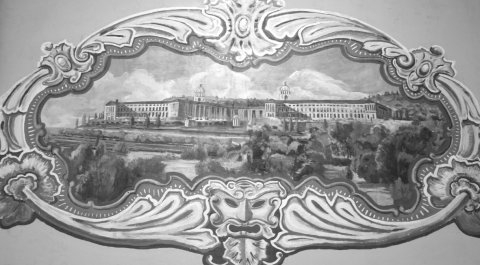
This recently rediscovered and restored mural in the Recreation Centre, Cullinan, depicts
the Union Buildings, Pretoria. It was originally painted in 1942 by Italian Prisoners of War.

Mural of Tower Bridge, London. This is one of eight such murals in the Recreation Centre, Cullinan.

This recently rediscovered and restored mural in the Recreation Centre, Cullinan, depicts
the Union Buildings, Pretoria. It was originally painted in 1942 by Italian Prisoners of War.
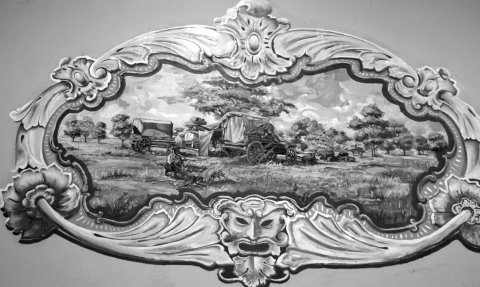
One of three Cullinan Recreation Centre murals with an Africana theme.
Four of the eight murals painted on the walls of the Recreation Club by Italian Prisoners of War in 1942 and now rediscovered and carefully restored follow in the photographs below:
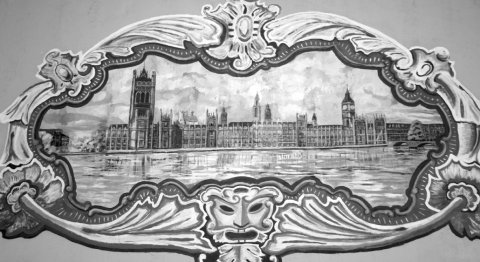
Westminster Abbey, London [should be Palace of Westminster i.e. Houses of Parliament]
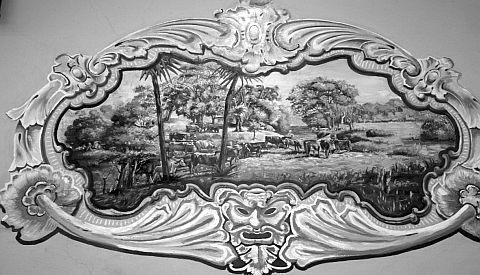
Africana scene [cattle grazing]
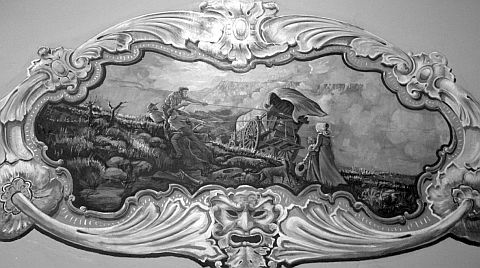
Africana scene [wagon in wind storm]
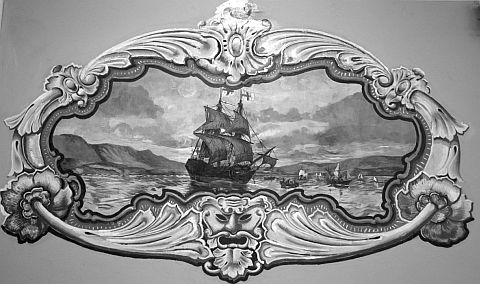
a sailing ship
Note - for a colour illustration of one of the murals see the Inside Front Cover
Return to Journal Index OR Society's Home page
South African Military History Society / scribe@samilitaryhistory.org